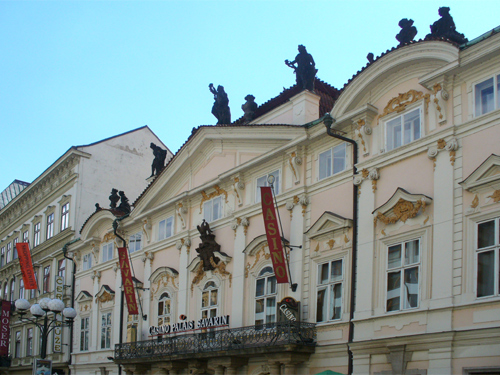 An 18th century baroque building near Wenceslaus Square, now a casino. Wencelaus is known to us from the Christmas carol by the name "Good King Wenceslaus." Considered an early martyr, he was associated with the first martyr, St. Stephen. Hence the first line of the Christmas carol, "Good King Wenceslaus looked out on the Feast of Stephen".
An 18th century baroque building near Wenceslaus Square, now a casino. Wencelaus is known to us from the Christmas carol by the name "Good King Wenceslaus." Considered an early martyr, he was associated with the first martyr, St. Stephen. Hence the first line of the Christmas carol, "Good King Wenceslaus looked out on the Feast of Stephen".
St. Wenceslaus was not a king but a Bohemian prince born about 903 AD. He was persecuted by his mother, Drahomira, and his brother because of their hatred for his Christianity, and was eventually killed by his brother in front of the doors of the Church of SS. Cosmas and Damian in 938 AD.
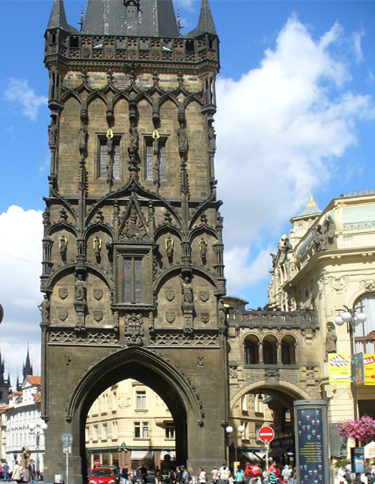 The neo-Gothic Powder Gate can trace its origins back to the 11th century, when the original gate was one of 13 entrances to Prague's Old Town.
Work on the present structure began during the reign of King Vladislav II in 1475 and was modeled on the Old Town Bridge Tower, built a century earlier.
Originally known as the New Tower, its name was changed to the Powder Gate in the 17th century when it was used to store gunpowder.
The neo-Gothic Powder Gate can trace its origins back to the 11th century, when the original gate was one of 13 entrances to Prague's Old Town.
Work on the present structure began during the reign of King Vladislav II in 1475 and was modeled on the Old Town Bridge Tower, built a century earlier.
Originally known as the New Tower, its name was changed to the Powder Gate in the 17th century when it was used to store gunpowder.
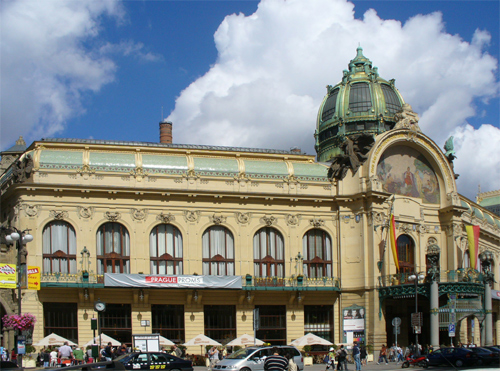 Next to it is the Municipal House, which was completed in 1911 and is the premier Art Nouveau building in Prague.
Situated on the site of the former Royal Court Palace, the front of the building has a mosaic and a balcony from which the independence of Czechoslovakia was announced in 1918.
Next to it is the Municipal House, which was completed in 1911 and is the premier Art Nouveau building in Prague.
Situated on the site of the former Royal Court Palace, the front of the building has a mosaic and a balcony from which the independence of Czechoslovakia was announced in 1918.
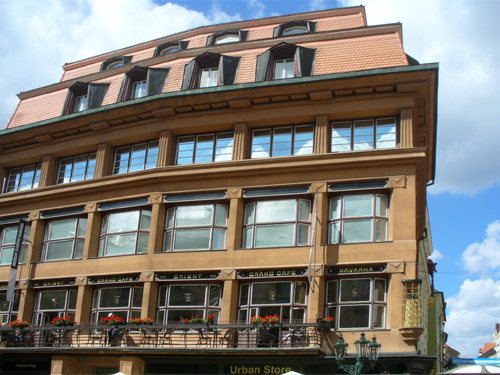
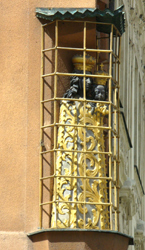
Yet another type of architecture, this is an example of Czech cubism with a Black Madonna in the corner.
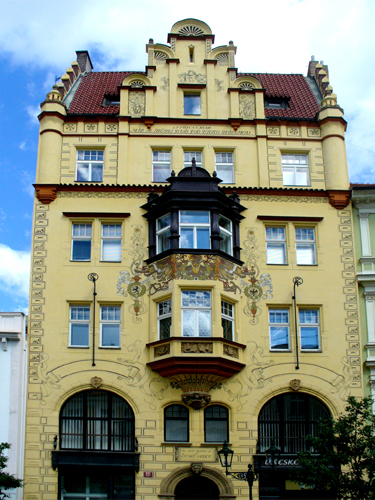 Another interesting building, with illustrations.
Another interesting building, with illustrations.
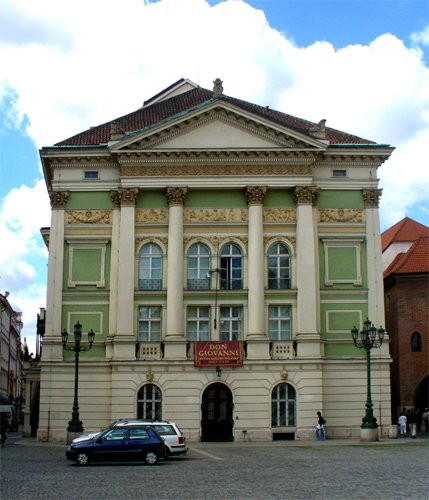 The rear of The Estates Theater, one of the finest examples of Neo-classicism. It was here that Amadeus Mozart himself conducted his Marriage of Figaro in spring 1787 and where he returned to in autumn the same year to conduct the world premiere of his Don Giovanni.
The rear of The Estates Theater, one of the finest examples of Neo-classicism. It was here that Amadeus Mozart himself conducted his Marriage of Figaro in spring 1787 and where he returned to in autumn the same year to conduct the world premiere of his Don Giovanni.
When we entered the town square, our guide told us about some of the history of the reformer, Jan Hus, who followed the teaching of John Wycliff, who translated the Bible into English in 1382. Both advocated the right of the common man to read the Bible in his own language. Both Wycliff and Huss believed scripture to supersede the dogmas and ordinances of the church. Hus especially questioned the use of indulgences and the Catholic mass, where the laity could eat the bread but only the priest was allowed to drink the wine from the cup or chalice. For this he was burned at the stake on July 6, 1415.
His movement also had political implications, involving the Czechs against the Hapsburgs, and moral implications, regarding the poor against the rich. For these reasons, Jan Hus is still a national hero today in the Czech Republic even though most Czechs describe themselves as non-religious, and among Christians there are more Roman Catholics than Hussites. July 6, the anniversary of the execution of Jan Hus, is still one of the public holidays in the Czech Republic.
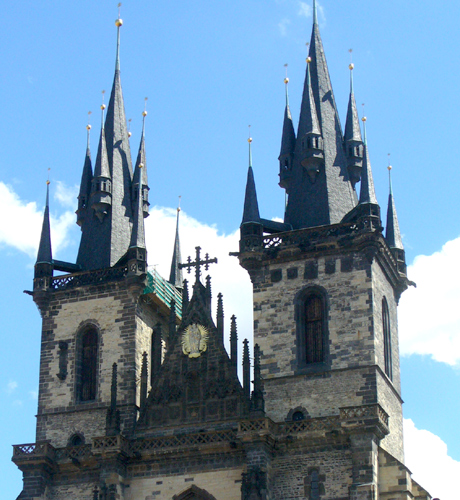 In the Town Square we first saw the Church of our Lady before Tyn. Construction of the present church started in the 14th century in late gothic style. At the beginning of the 15th century, construction was almost done; only the towers, gable and roof were missing. The church was controlled by Hussites for some time, and during this time
The roof was completed, while the gable and northern tower were completed shortly thereafter. On the gable was placed a huge golden chalice, the symbol of the Hussites. The southern tower was not completed until 1511.
In the Town Square we first saw the Church of our Lady before Tyn. Construction of the present church started in the 14th century in late gothic style. At the beginning of the 15th century, construction was almost done; only the towers, gable and roof were missing. The church was controlled by Hussites for some time, and during this time
The roof was completed, while the gable and northern tower were completed shortly thereafter. On the gable was placed a huge golden chalice, the symbol of the Hussites. The southern tower was not completed until 1511.
In 1626, after the Battle of the White Mountain, where the Hussites were defeated, the chalice was melted down and replaced by a sculpture of The Madonna, made with gold from the chalice.
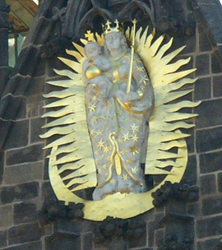
A telephoto shot of the Madonna.
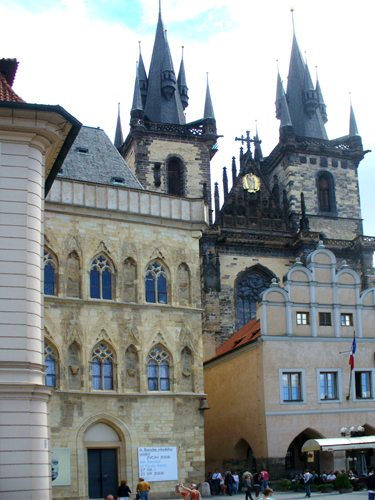 The church is behind other buildings. Although the exterior of the church is Gothic, the interior is baroque. We were not able to take photos inside.
The church is behind other buildings. Although the exterior of the church is Gothic, the interior is baroque. We were not able to take photos inside.
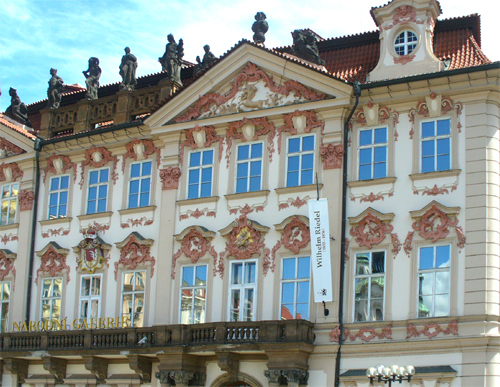 Next to the church is the rococo Goltz-Kinsky's Palace, now housing collections of the National Gallery.
Next to the church is the rococo Goltz-Kinsky's Palace, now housing collections of the National Gallery.
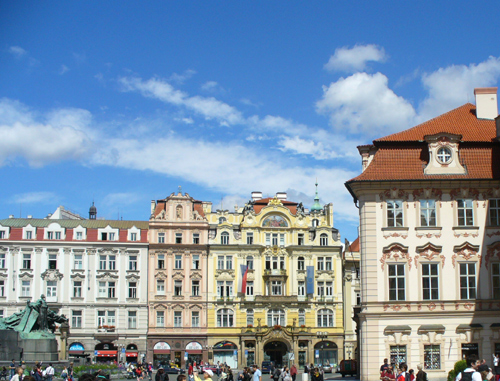 Looking at another side of the square at more buildings and the monument to Jan Hus at the left.
Looking at another side of the square at more buildings and the monument to Jan Hus at the left.
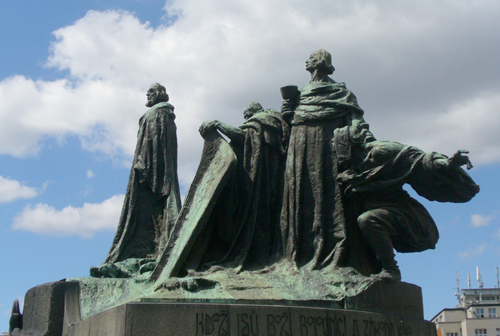 A view of the monument with Jan Hus to the left and victorious Hussite warriors on the right. The largest figure on the right is holding a chalice, the symbol of the Hussite movement.
A view of the monument with Jan Hus to the left and victorious Hussite warriors on the right. The largest figure on the right is holding a chalice, the symbol of the Hussite movement.
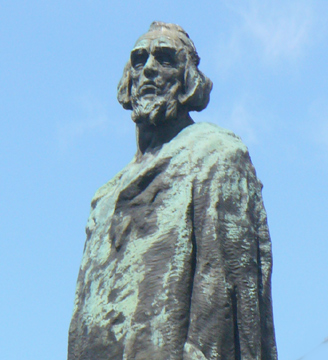 A closeup of the statue of Jan Hus, showing his determination. At his trial, his accusers convicted him of heresy and said, "We will take from you the cup of redemption." Hus replied, "I trust in the Lord God Almighty...that He will not take away from me the cup of redemption, but I firmly hope to drink of it today in His kingdom."
A closeup of the statue of Jan Hus, showing his determination. At his trial, his accusers convicted him of heresy and said, "We will take from you the cup of redemption." Hus replied, "I trust in the Lord God Almighty...that He will not take away from me the cup of redemption, but I firmly hope to drink of it today in His kingdom."
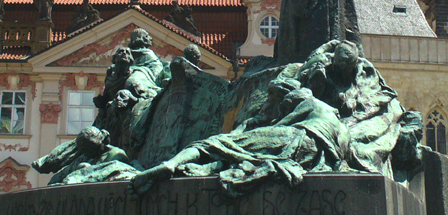 On the other side of the monument we see figures representing Protestants who were forced into exile 200 years after Hus as well as a young mother which symbolizes national rebirth.
On the other side of the monument we see figures representing Protestants who were forced into exile 200 years after Hus as well as a young mother which symbolizes national rebirth.
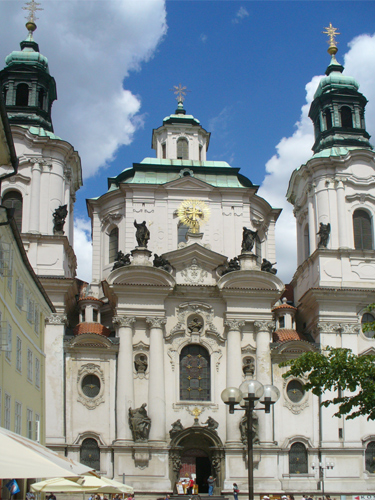 At another corner of the Town Square is the Baroque St. Nicholas Church, originally completed in 1735.
At another corner of the Town Square is the Baroque St. Nicholas Church, originally completed in 1735.
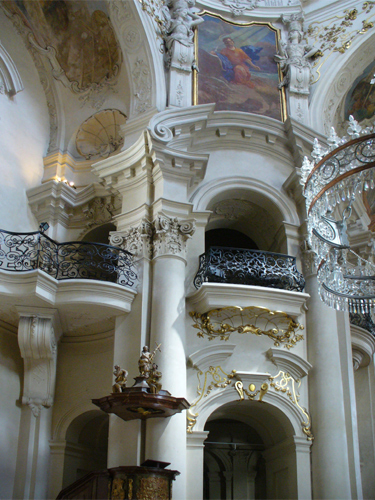
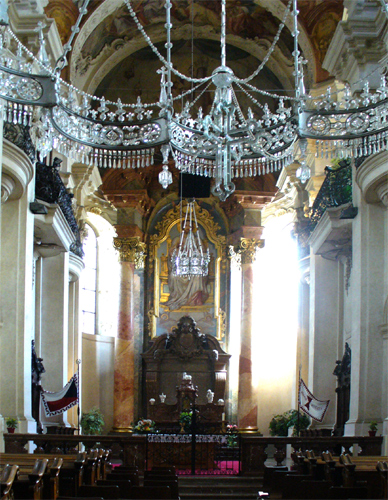
The interior design was inspired by the chapel of St. Louis-des-invalides in Paris. From 1870-1914 St. Nicholas became Russian Orthodox. Then, during the second World War, Czech army units were stationed here and artists were set to work restoring the church.
After the war, St. Nicholas was handed over to the Czech Hussite movement, with whom it remains today. It serves as both a church and a magnificent venue for classical concerts.
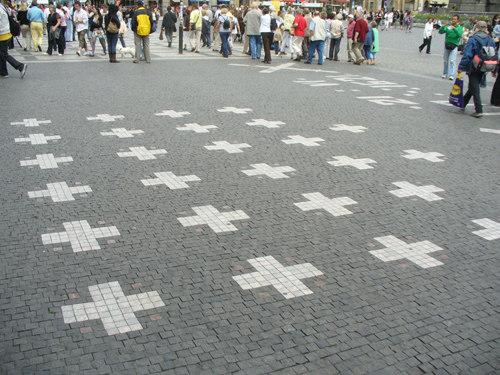 One of the leaders of movement of the Hussites, Jan Jelivsky, was executed here in the Old Town Square in the 15th century. After the victory of Catholics over the Protestants in 1521 27 people, those who took part at the battle at the White Mountain, were put to death on the same square. White crosses in front of the city-hall show the place where the scaffold was situated in Middle Ages.
One of the leaders of movement of the Hussites, Jan Jelivsky, was executed here in the Old Town Square in the 15th century. After the victory of Catholics over the Protestants in 1521 27 people, those who took part at the battle at the White Mountain, were put to death on the same square. White crosses in front of the city-hall show the place where the scaffold was situated in Middle Ages.
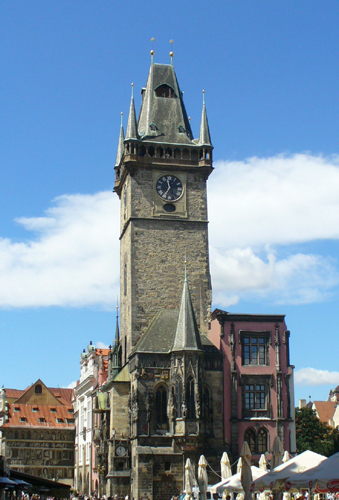 Since the middle of the 14th century, the Old Town Hall has watched over Old Town Square.
Since the middle of the 14th century, the Old Town Hall has watched over Old Town Square.
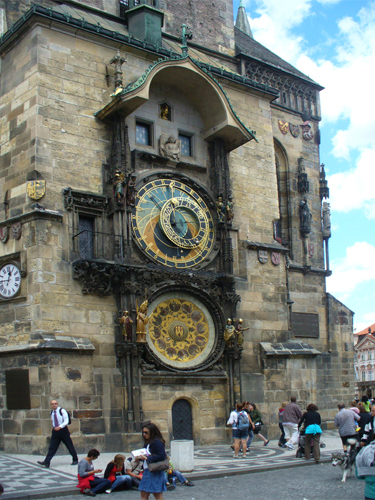 The famous astronomical clock on the side of the Old Town Hall. It contains figures of the 12 apostles from 1410.
The famous astronomical clock on the side of the Old Town Hall. It contains figures of the 12 apostles from 1410.
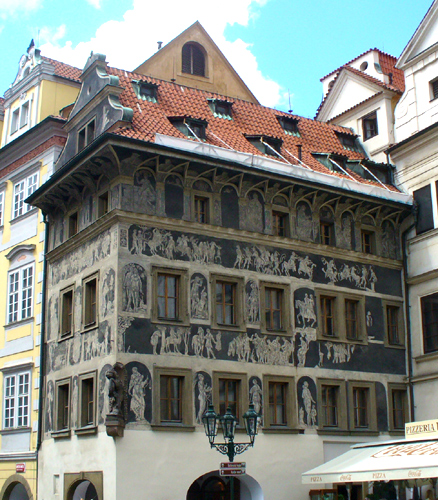 Our official tour ended here. As Elizabeth and I walked toward Charles Bridge, we saw this decorated building.
Our official tour ended here. As Elizabeth and I walked toward Charles Bridge, we saw this decorated building.
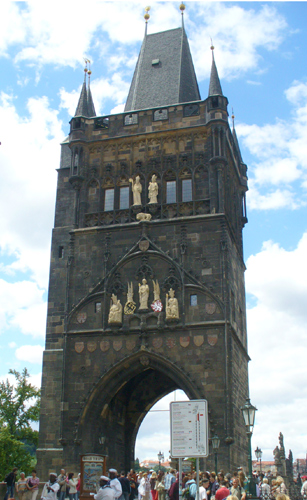 Our first view of the north tower of the Charles Bridge.
Our first view of the north tower of the Charles Bridge.
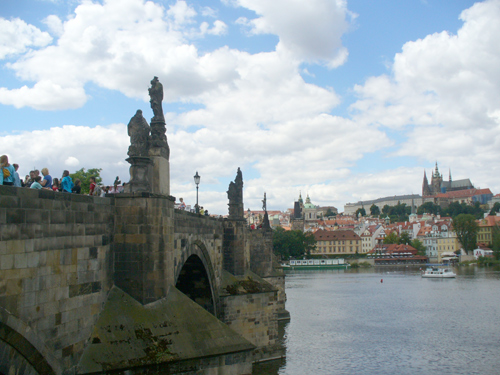 A side view of the bridge, with a few of its many statues. Castle Hill and the Cathedral of St. Vitus can be seen to the right.
A side view of the bridge, with a few of its many statues. Castle Hill and the Cathedral of St. Vitus can be seen to the right.
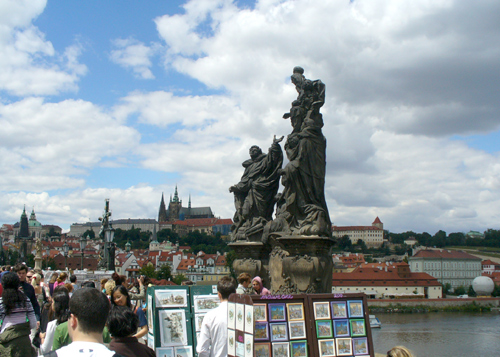 A view on the bridge itself, with statues and one of many vendors with goods for sale.
A view on the bridge itself, with statues and one of many vendors with goods for sale.
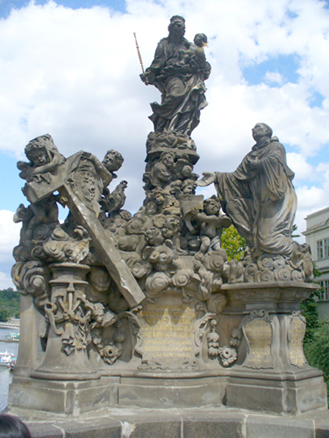
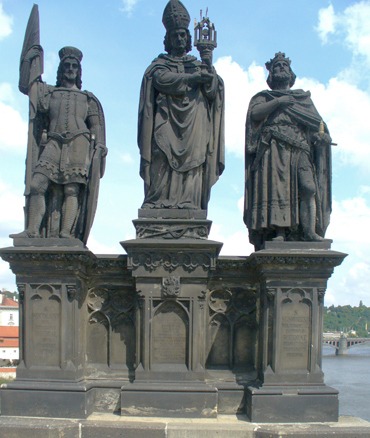
On the left is a statue of the Madonna and St. Bernard. St. Wenceslaus is in the center of the statue on the right.
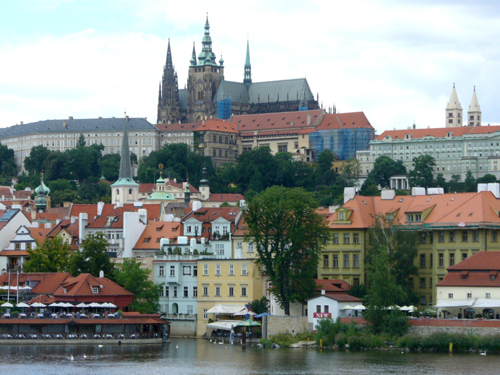 From the bridge there is a view of the Prague Castle and St. Vitus's Cathedral.
From the bridge there is a view of the Prague Castle and St. Vitus's Cathedral.
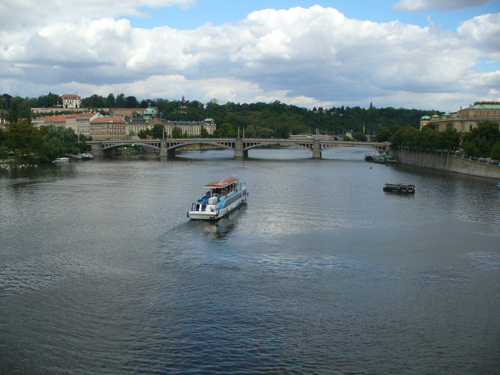 A view of the river in the other direction.
A view of the river in the other direction.
The next day we will do more sightseeing in Prague.
